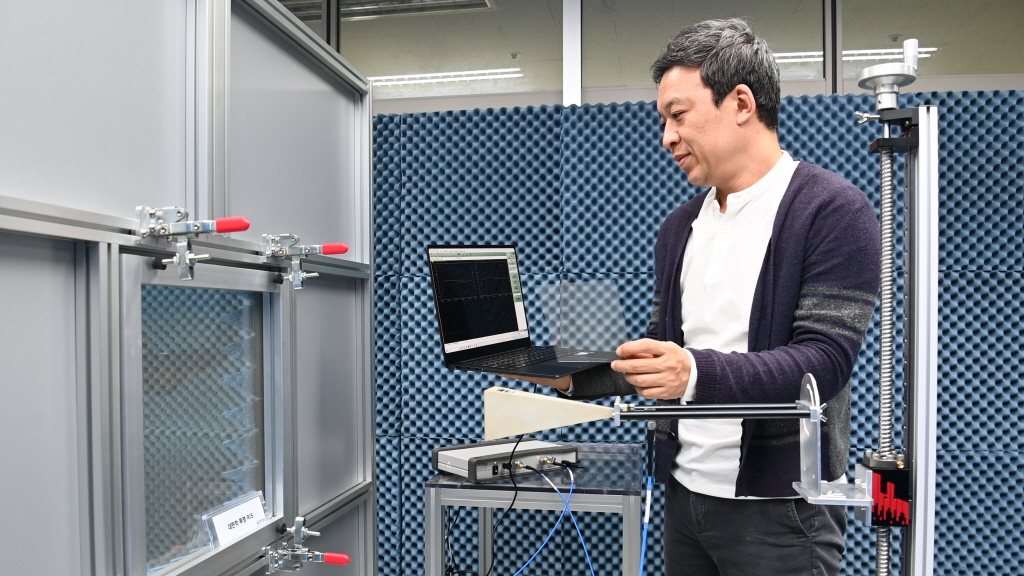한국전자통신연구원(ETRI)이 중계기 없이도 실내에서 밀리미터파 대역의 이동통신을 원활히 지원할 수 있는 신기술을 개발했다.

▲ETRI가 개발한 고투과, 광대역, 광각 특성을 가진 투명 지능형 재구성 안테나(RIS) 기술을 ETRI 연구진이 시연하는 모습
건물 창문 부착 가능 초소형 RIS 안테나
건물 유리에 붙여 실내 밀리미터파 통신영역 확장이 가능한 핵심기술이 개발돼 향후 중계기가 없이도 밀리미터파 대역 이동통신의 실내 통신이 가능할 것으로 기대가 모아진다.
한국전자통신연구원(ETRI)이 중계기 없이도 실내에서 밀리미터파 대역의 이동통신을 원활히 지원할 수 있는 신기술을 개발했다고 20일 발표했다.
이번 성과는 고주파 통신의 어려움을 극복하고 실내 통신 품질을 획기적으로 향상시킬 혁신적인 기술로 주목받고 있다.
ETRI는 밀리미터파(mmWave) 대역에서 高투과, 광대역, 광각 특성을 갖춘 지능형 재구성 안테나(RIS) 기술을 공개했다. 이 기술은 필름 형태의 초소형 배열 안테나를 건물 유리창이나 벽면에 부착해 고주파 신호를 효과적으로 실내로 전달하며, 기존 중계기 설치에 필요한 고비용 문제를 해결한다. 특히, 유리에 형성된 미세 패턴을 활용해 전파의 투과도를 높이는 방식으로, 전파 손실을 줄이고 통신 품질을 대폭 향상시킬 수 있다.
ETRI가 개발한 고투과·광대역·광각 RIS는 기존 기술 대비 대역폭이 약 10배 넓어, 하나의 RIS로 5G, 이음 5G, 향후 6G 서비스까지 동시에 지원 가능하다.
또한 80도 이상의 투과 광각에서도 일정한 고투과 특성을 유지해 실내 음영지역 해소와 데이터 속도 향상에 기여할 것으로 기대된다.
연구진은 추가적인 중계기 없이도 건물 창문에 RIS 필름을 부착하는 것만으로 실내 통신 커버리지를 획기적으로 확대할 수 있는 기술적 기반을 마련했다고 밝혔다.
ETRI는 실내 통신 영역 확장을 위해 ‘산란형 RIS 기술’ 연구도 병행하고 있다. 이 기술은 실내로 전파되는 고주파 신호를 넓은 범위로 재전파해 통신 영역을 확장하며, 별도의 전원이 필요 없어 에너지 효율적인 미래 전파 기술로 평가받고 있다.
현재 ETRI 연구진은 일반 유리 대비 약 4배 향상된 투과손실 개선 수준을 달성했으며, 이를 6배로 끌어올려 코팅 및 열차단 유리에서도 최적의 성능을 발휘할 수 있도록 개발을 지속할 계획이다. 연구진은 향후 3년 내 상용화를 목표로 기술을 안테나 소재부품 회사에 이전해 실질적인 응용 단계로 나아갈 방침이다.
ETRI 전파환경감시연구실의 이정남 박사는 “본 기술은 고주파 통신의 한계를 극복하여 실내 통신 품질을 혁신적으로 향상시키는 데 기여할 것”이라며 “우리나라 전파기술의 영역 확장을 위해 지속적으로 노력하겠다”고 밝혔다.
이번 연구는 과학기술정보통신부와 정보통신기획평가원의 지원을 받아 진행되었으며, ㈜클레버로직과 ㈜덕산넵코어스가 공동 연구기관으로 참여했다.